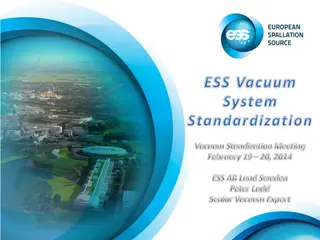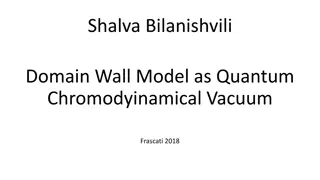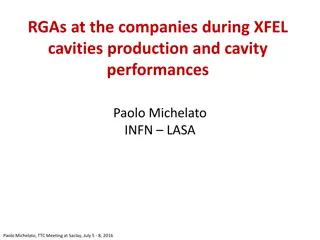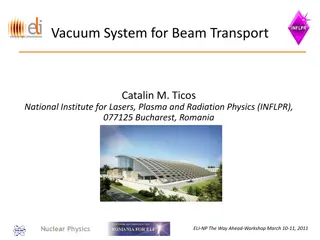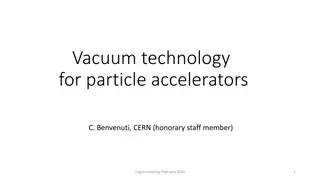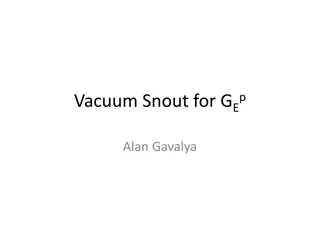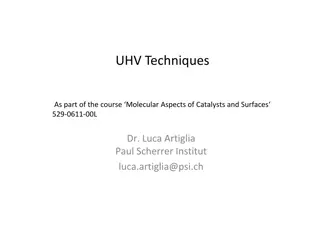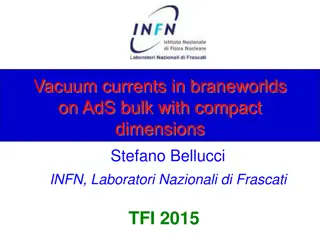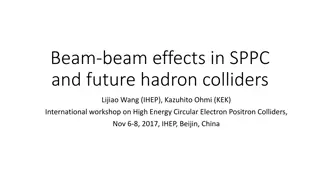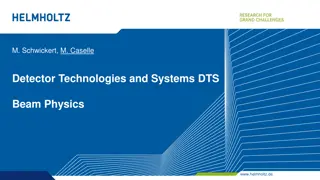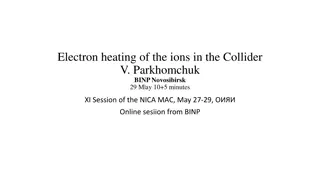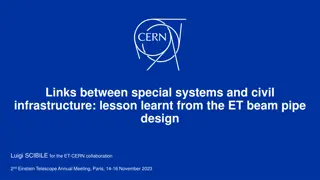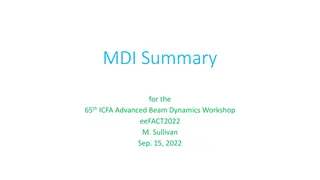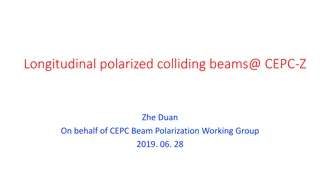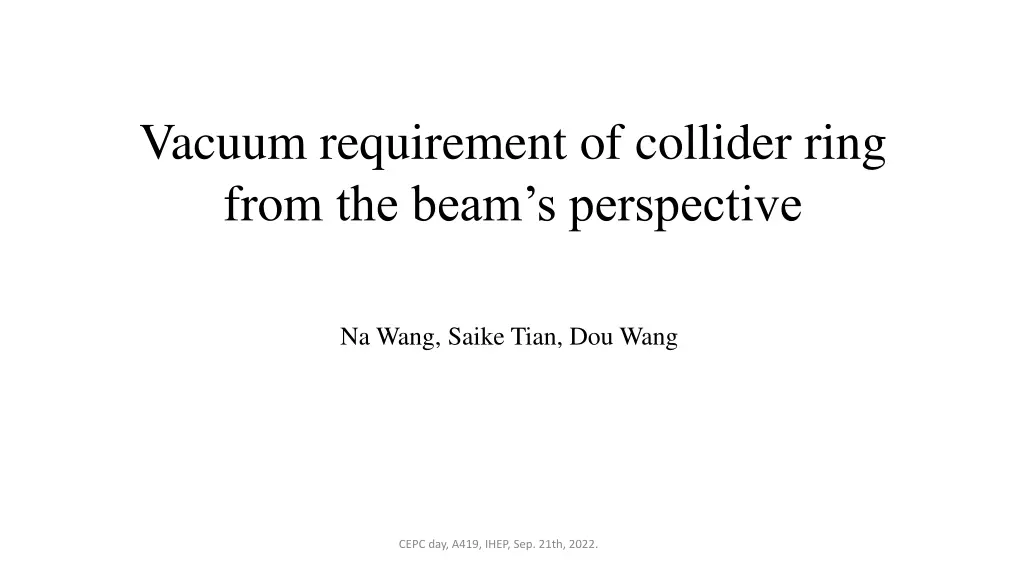
Understanding Vacuum Requirements for Collider Rings
Explore the vacuum requirements for collider rings from the beam's perspective, including vacuum lifetimes for different modes, impact of low vacuum conditions, and specific scenarios like beam-gas interactions and instabilities.
Download Presentation

Please find below an Image/Link to download the presentation.
The content on the website is provided AS IS for your information and personal use only. It may not be sold, licensed, or shared on other websites without obtaining consent from the author. If you encounter any issues during the download, it is possible that the publisher has removed the file from their server.
You are allowed to download the files provided on this website for personal or commercial use, subject to the condition that they are used lawfully. All files are the property of their respective owners.
The content on the website is provided AS IS for your information and personal use only. It may not be sold, licensed, or shared on other websites without obtaining consent from the author.
E N D
Presentation Transcript
Vacuum requirement of collider ring from the beam s perspective Na Wang, Saike Tian, Dou Wang CEPC day, A419, IHEP, Sep. 21th, 2022.
Outline Vacuum lifetime for Higgs mode Vacuum lifetime for Z mode Vacuum requirement due to the instability issue Summary of vacuum requirement for four energies 2
Impact of low vacuum condition Beam lifetime injection capability (top up) integrated luminosity - Beam-gas elastic scattering - Beam-gas bremsstrahlung - Beam-gas electron bremsstrahlung - Beam-gas electron elastic scattering Fast beam-ion instability (electron ring) emittance growth luminosity - beam oscillation luminosity - 3
Beam-gas elastic scattering @ Higgs Average : 49m/49m Assumption for residual gas ingredients: -- H2 80%, CO 20% Transverse aperture: dynamic aperture (12 x/20 y) 4
Beam-gas bremsstrahlung @ Higgs Assumption for residual gas ingredients: -- H2 80%, CO 20% Energy acceptance: DA acceptance (1.6%) 5
Beam-gas electron bremsstrahlung @ Higgs Assumption for residual gas ingredients: -- H2 80%, CO 20% Energy acceptance: DA acceptance (1.6%) 6
Beam-gas electron elastic scattering @ Higgs Assumption for residual gas ingredients: -- H2 80%, CO 20% Energy acceptance: DA acceptance (1.6%) 7
Vacuum lifetime @ Higgs 1 1 1 1 1 = + + + 1 2 3 4 CEPC vacuum lifetime for Higgs is dominated by beam-gas elastic scattering. CEPC vacuum lifetime is sensitive to the vertical dynamic aperture. 8
Vacuum lifetime @ Z Average : 64m/64m Assumption for residual gas ingredients: -- H2 80%, CO 20% Energy acceptance: DA acceptance (1.3%) Transverse aperture: dynamic aperture (15 x/25 y) 1 1 1 1 1 = + + + 1 2 3 4 9
Vacuum lifetime @ Z beam-gas bremstrahlung beam-gas scattering beam-gas electron scattering beam-gas electron bremstrahlung 10
30MW operation @Z Beam lifetime: > 0.9 h (injection requirement) Vacuum lifetime: > 4 h Vacuum quality: < 0.6 ntorr Vacuum lifetime 1000 100 lifetime (h) 10 1 0.1 0.01 1.0E-12 1.0E-11 1.0E-10 1.0E-09 1.0E-08 1.0E-07 1.0E-06 Pressure (torr) 11
10MW operation @Z Beam lifetime: > 0.6 h (injection requirement) Vacuum lifetime: > 2 h Vacuum quality: < 1.2 ntorr Vacuum lifetime 1000 100 lifetime (h) 10 1 0.1 0.01 1.0E-12 1.0E-11 1.0E-10 1.0E-09 1.0E-08 1.0E-07 1.0E-06 Pressure (torr) 12
Cross check for vacuum lifetime @Z S. K. Tian Computation of gas scattering lifetime using a fixed pressure and gas mixture Use the two specialized tools with ELEGANT elasticScatteringLifetime: 3.5 h Input parameters or files aperture DA file twiss file pressure customGas bremsstrahlungLifetime: 194 h Input parameters or files aperture LMA file pressure customGas CustomGas used here H2:0.8, H2O:0.0, CH4:0.0, CO:0.2, CO2:0.0 Pressure: 1nTorr 2.9 h@1ntorr 258 h@1ntorr
Lifetime simulations for Z S. K. Tian The DA data @ Injection Points used for elastic scattering lifetime The LMA data used for bremsstrahlung lifetime assumed a fixed value 1.3%
Fast beam ion instability Na Wang With vacuum pressure of 1nTorr, and CO has been considered as the only ion species Consider multi bunch train filling pattern The instability growth calculated by the analytical theory for W and Z are faster than SR damping. Build-up of ions along the bunch train 15
Simulations for Z Na Wang, S. K. Tian Particle tracking simulations with uniform filling and multi-train filling Although multi-train filling is effective in mitigating the beam ion instability, emittance growth is still foreseen. Instability needs to be damped by multi-train filling and bunch-by-bunch feedback. uniform x/ y=92/32m x/ y=69/96m x/ y=0.13/9E-4m multi-train 16
Summary of vacuum requirement (30MW/50MW) Requirement [ntorr] Design status [ntorr] tt Higgs 2/1.8 1.1/1.7 W Z 10/9 4.1/6.5 1.5/1.3 1.5/2.1 0.8/0.6 1.0/1.8 17
Design status of vacuum system Y. S. Ma @IHEP, eeFACT2022 18
Summary Both beam lifetime and instability for CEPC collider ring due to vacuum condition is studied continuously. Tentative requirements for the vacuum level at four energy modes are proposed from the view of beam physics. So far, the vacuum requirements for ttbar, H, and W can be reached. Z pole is the most demanding energy according to the issue of vacuum. Keep possibility of vacuum improvement for the future higher power operation at Z pole. The vacuum specifications of CEPC will be verified on HEPS to some extent. 19


